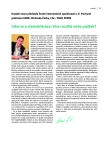Residual cardiovascular risk markers
Authors:
Hana Rosolová; Barbora Nussbaumerová
Authors‘ workplace:
Centrum preventivní kardiologie II. interní kliniky LF UK a FN Plzeň, přednosta prof. MUDr. Jan Filipovský, CSc.
Published in:
Vnitř Lék 2014; 60(11): 937-941
Category:
Reviews
Overview
The European definition of biomarker is presented; it is a measurable factor, which reflects a physiological or pathological process in human body. There are also mentioned transferred meanings of the term marker used in different fields of medicine. The importance, categorization and calculation of global cardiovascular (CV) risk are explained in patients in primary prevention of CV disease (SCORE risk chart). Residual CV risk persists in patients in primary or secondary prevention of CV diseases treated according to current guidelines, even if their risk factors (blood pressure, LDL-cholesterol, glucose level) have achieved the recommended values. This residual risk was done by non-LDL dyslipidemia especially, so called atherogenic dyslipidemia (Residual Risk Reduction Initiative definition). Investigators of preventive EUROASPIRE studies assessed, that 5-year mortality from CV diseases was in a positive association with glucose level, smoking and total cholesterol. In our recent analysis, we have described among the Czech samples of EUROASPIRE studies I-IV, that BMI and prevalence of diabetes increase during the last 16 years very steeply. Patients with stable coronary heart diseases in combination with diabetes have had higher prevalence of residual risk markers (atherogenic dyslipidemia, atherogenic index of plasma described by M. Dobiasova and hypertriglyceridemic waist) than patients without diabetes. Except of prescription of statins, ACE inhibitors, antiaggregative or anticoagulative drugs was increasing, the residual CV risk was not changing during the followed period of 16 years.
Key words:
atherogenic dyslipidemia – biomarker – cardiovascular risk – residual risk
Sources
1. European Association for Predictive, Preventive and Personalised Medicine (EPMA). Dostupné z WWW: <http://www.epmanet.eu>.
2. Perk J, De Backer G, Gohlke H et al. European Guidelines on cardiovascular disease prevention in clinical practice (version 2012). The Fifth Joint Task Force of the European Society of Cardiology and Other Societies on Cardiovascular Disease Prevention in Clinical Practice (constituted by representatives of nine societies and by invited experts). Eur Heart J 2012; 33(13): 1635–1701. Erratum in Eur Heart J. 2012; 33(17): 2126.
3. Barter P, Gotto AM, Phil D et al. HDL Cholesterol, Very Low Levels of LDL Cholesterol, and Cardiovascular Events. N Engl J Med 2007; 357(13): 1301–1310.
4. Fruchart JCh, Sacks FM, Hermans MP et al. The Residual Risk Reduction Initiative: a call to action to reduce residual vascular risk in dyslipidaemic patient. Diab Vasc Dis Res. 2008; 5(4):319–335.
5. Varbo A, Benn M, Nosdestgaard BG. Remnant cholesterol as a cause of ischemic heart disease : Evidence, definition, measurement, atherogenicity, high risk patients, and present and future treatment. Pharmacol Ther 2014; 141(3): 358–367.
6. Varbo A, Benn M, Tybjaerg-Hansen A et al. Remnant cholesterol as a causal risk factor for ischaemic heart disease. J Am Coll Cardiol 2013; 61(4): 427–436.
7. De Bacquer D, Dallongeville J, Kotseva K et al. Residual risk of cardiovascular mortality in patients with coronary heart disease: the EUROASPIRE Risk Categories. Int J Cardiol 2013; 168(2): 910–914.
8. Lemieux A, Pascot C, Couillard D. et al. Hypertriglyceridemic waist: A marker of the atherogenic metabolic triad (hyperinsulinemia; hyperapolipoprotein B; small, dense LDL) in men? Circulation 2000; 102(2): 179–184.
9. Dobiasova M, Frohlich J. New atherogenic index of plasma (AIP) represents the ratio of triglycerides and HDL-cholesterol concentrations, correlates with lipoprotein particle size and cholesterol esterification rate: changes after Lipanor treatment (in Czech). Vnitř Lék 2000; 46(3): 152–156.
10. Dobiasova M, Frohlich J. The plasma parameter log (TG/HDL-C) as an atherogenic index: correlation with lipoprotein particle size and esterification rate in Apo-B-lipoprotein-depleted plasma (FERHDL). Clin Biochem 2001; 34(7): 583–588.
11. Calculator of atherogenic risk – AIP calculator. Dostupné z WWW: <http://www.biomed.cas.cz/fgu/aip/calculator.php>.
12. Nussbaumerova B, Rosolova H, Mayer O et al. Residual cardiovascular risk in patients with stable coronary heart disease over the past 16 years (Czech part of the EUROASPIRE I-IV surveys). Cor et Vasa 2014; 56(2): e98-e104.
13. Mayer Jr, O, Bruthans J, Timoracká K on behalf of Czech EUROASPIRE I-IV investigators. The changes in cardiovascular prevention practice between 1995 and 2012 in the Czech Republic. A comparison of EUROASPIRE I, II, III and IV study. Cor et Vasa 2014; 56(2): e91-e97.
Labels
Diabetology Endocrinology Internal medicineArticle was published in
Internal Medicine

2014 Issue 11
Most read in this issue
- New aspects of hormone replacement therapy
- LDL-apheresis in the treatment familial hypercholesterolemia
- New SGLT2 inhibitor empagliflozin: modern and safe treatment of diabetes
- Extended options of anticoagulant treatment in thromboembolism
